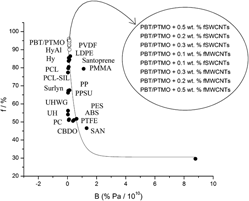Crossref Citations
This article has been cited by the following publications. This list is generated based on data provided by
Crossref.
Yuan, Cuiping
Chen, Guangming
and
Yang, Jiping
2012.
Orientation Structures in Injection-Molded Pellets of Polystyrene/Carbon Nanotube Nanocomposites.
Industrial & Engineering Chemistry Research,
Vol. 51,
Issue. 36,
p.
11695.
Paszkiewicz, S.
Szymczyk, A.
Špitalský, Z.
Soccio, M.
Mosnáček, J.
Ezquerra, T. A.
and
Rosłaniec, Z.
2012.
Electrical conductivity of poly(ethylene terephthalate)/expanded graphite nanocomposites prepared by in situ polymerization.
Journal of Polymer Science Part B: Polymer Physics,
Vol. 50,
Issue. 23,
p.
1645.
Schwarzer, N
2014.
From interatomic interaction potentials via Einstein field equation techniques to time dependent contact mechanics.
Materials Research Express,
Vol. 1,
Issue. 1,
p.
015042.
Peponi, Laura
Puglia, Debora
Torre, Luigi
Valentini, Luca
and
Kenny, José M.
2014.
Processing of nanostructured polymers and advanced polymeric based nanocomposites.
Materials Science and Engineering: R: Reports,
Vol. 85,
Issue. ,
p.
1.
Pilawka, Ryszard
Paszkiewicz, Sandra
and
Rosłaniec, Zbigniew
2014.
Thermal degradation kinetics of PET/SWCNTs nanocomposites prepared by the in situ polymerization.
Journal of Thermal Analysis and Calorimetry,
Vol. 115,
Issue. 1,
p.
451.
Carrión-Vilches, F.J.
González-Vivas, A.
Martínez-Mateo, I.J.
and
Bermúdez, M.D.
2015.
Study of the abrasion resistance under scratching of polybutylenetereftalate–glass fiber composites.
Tribology International,
Vol. 92,
Issue. ,
p.
365.
Sarkar, Biswajit
and
Alexandridis, Paschalis
2015.
Block copolymer–nanoparticle composites: Structure, functional properties, and processing.
Progress in Polymer Science,
Vol. 40,
Issue. ,
p.
33.
Jia, Yuan
Yan, Hong-Xia
Li, Song
and
Liu, Tianye
2016.
Tribology Property of Benzoxazine–Bismaleimide Composites with Hyperbranched Polysilane-Grafted Multi-Walled Carbon Nanotubes.
Nano,
Vol. 11,
Issue. 06,
p.
1650061.
Salgado-Delgado, R.
Olarte-Paredes, A.
Vargas-Galarza, Z.
García-Hernández, E.
Salgado-Delgado, A. M.
Rubio-Rosas, E.
Campos-Álvarez, J.
and
Castaño, V. M.
2016.
Electrical Properties of Polymer/Carbon Nanotube Blends.
Journal of Electronic Materials,
Vol. 45,
Issue. 10,
p.
5341.
Brostow, Witold
and
Hagg Lobland, Haley E.
2016.
Survey of Relations of Chemical Constituents in Polymer-Based Materials with Brittleness and its Associated Properties.
Chemistry & Chemical Technology,
Vol. 10,
Issue. 4s,
p.
595.
Tian, Yan
Zhang, Hui
Zhao, Jun
Li, Tao
Bie, Bi-Xiong
Luo, Sheng-Nian
and
Zhang, Zhong
2016.
High strain rate compression of epoxy based nanocomposites.
Composites Part A: Applied Science and Manufacturing,
Vol. 90,
Issue. ,
p.
62.
Kortaberria, Galder
2016.
Block Copolymer Nanocomposites.
p.
69.
Berman, Diana
Brostow, Witold
Lobland, Haley E. Hagg
Perez, Jose M.
and
Khare, Neelima
2017.
Friction, Lubrication, and Wear Technology.
p.
550.
Brostow, Witold
Lobland, Haley
Hnatchuk, Nathalie
and
Perez, Jose
2017.
Improvement of Scratch and Wear Resistance of Polymers by Fillers Including Nanofillers.
Nanomaterials,
Vol. 7,
Issue. 3,
p.
66.
Eroğlu, Gülden
Gündüz, Güngör
Çolak, Üner
and
Mavis, Bora
2018.
Use of functionalized boehmite nanoparticles to improve the hardness and tribological properties of polyurethane films.
Journal of Polymer Research,
Vol. 25,
Issue. 2,
Kausar, Ayesha
2020.
Nanocomposites of poly(ε-caprolactone) with nanocarbon and inorganic nanoparticles: a versatile platform for industrial applications.
Materials Research Innovations,
Vol. 24,
Issue. 6,
p.
373.
Donchak, Volodymyr
Stetsyshyn, Yurij
Bratychak, Michael
Broza, Georg
Harhay, Khrystyna
Stepina, Nataliia
Kostenko, Mariia
and
Voronov, Stanislav
2021.
Nanoarchitectonics at surfaces using multifunctional initiators of surface-initiated radical polymerization for fabrication of the nanocomposites.
Applied Surface Science Advances,
Vol. 5,
Issue. ,
p.
100104.





